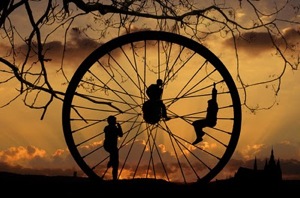
CASE #25: Keichū the Wheelmaker
Gettan Oshō said, “Keichū, the first wheelmaker, made a cart whose wheels had a hundred spokes. Now, suppose you took a cart and removed both the wheels and the axle. What would you have?”
BACKGROUND:
Gettan Oshō An earlier Ch’an master in the lineage of Mumon (1183–1260), the author of the Gateless Gate. The present koan appears in that ancient koan collection as Case 8.
Keichū The originator of the wheel according to Chinese mythology.
A hundred spokes Actually, the cart had two wheels, each with fifty spokes, for a total of one hundred. A wheel with fifty spokes (clearly too many) is probably meant to suggest excess, or that the cart is exceptionally big.
Removed both the wheels and the axle The image alludes to a verse from the Tao Te Ching which reads:
Thirty spokes make a wheel,
But it’s the hole at the center
That makes it turn.
The wheel is also one of the oldest and most easily recognized symbols of the Buddha Dharma.
COMMENTARY:
In his book Two Zen Classics, Katsuki Sekita interprets the wheels to mean our body, while the axle represents our brain—in which case the question would read, “What happens when both body and mind have fallen away (presumably in samadhi, or meditative absorption)?” But what’s to be gained from playing some kind of rarified Zen game?
Axles for brains and wheels for bodies—what nonsense! Just take a cart. Then take away the axle and the wheels. What’ve you got? The answer is a cart that won’t go anywhere. Now there’s a koan! Because what on Earth could be the point of that?
VERSE:
The Earth is wheel-less
But it turns, has no axle
But doesn’t wobble.
Progress is an illusion,
And travel doesn’t exist.
Thank you for subscribing to Tricycle! As a nonprofit, we depend on readers like you to keep Buddhist teachings and practices widely available.